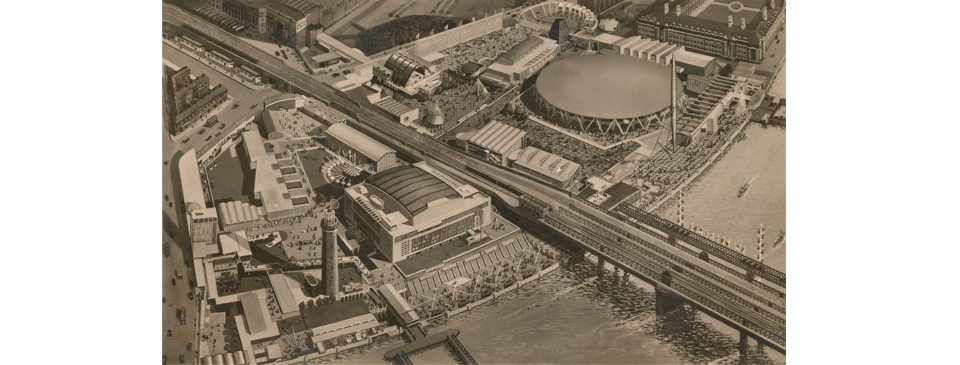The Festival of Britain – A Tonic To The Nation

The South Bank site of the Festival of Britain, as seen on a contemporary souvenir postcard. It clearly shows the two sections, divided by the Hungerford Bridge railway viaduct. The Dome of Discovery and Festival Hall dominate. Other notable features include the Shot Tower (lower left) and the tall Skylon.
In 1951 the Festival of Britain was held to give the country a boost in a period of hardship following the Second World War. Although conceived as a national event, its main focus was a site beside the Thames at Lambeth, what has subsequently become known as the ‘South Bank’.
London has a history of holding major festivals at key periods for the country. During the mid-19th century the British Empire was at its greatest and the United Kingdom was the world’s leading industrial nation. Thus, in 1851 the Great Exhibition was held in Hyde Park. Following the Great War, the empire was beginning to fracture, and other powers were threatening Britain’s position as the world leader. It was against that background that the British Empire Exhibition of 1924 took place at Wembley, leaving the original stadium as its legacy. In the 1940s the country was almost brought to its knees and the idea for a new exhibition to revive the spirit of the earlier events was born.
Both the exhibitions of 1924 and 1951 were held six years after terrible wars, and in the case of the former also following the Spanish influenza pandemic in which around a quarter of a million Britons had perished. They were thus, in part at least, held to invigorate the war-weary survivors following the shocks of those events. The aim of the British Empire Exhibition was also to strengthen the bonds of the empire.
The mid-1940s, with a serious threat of invasion and the country’s major cities reeling from enemy bombing, were one of the bleakest periods for Britain. Yet there were some who looked forward to a time when conflict would end. The origin of the Festival of Britain was a proposal from the Royal Society of Arts in 1943, during the height of the Second World War. Two years later, Gerald Barry, editor of the News Chronicle, followed up the idea with an open letter to Sir Stafford Cripps, President of the Board of Trade, proposing “a great Trade and Cultural Exhibition, to be held in London during the centenary year of the Great Exhibition.” At that time the thought was of an international exhibition, as the Great Exhibition had been.
Yet the country was at a low ebb, a period of austerity, with rations more severe than during the war, a lack of manpower, power shortages, and labour strikes. The jubilations following the end of the war had long passed and the country was in a time of national gloom. People were suffering from rationing and endless queues. Britain’s economy was in poor shape. In 1947 Cripps felt that London, still bearing the deep scars of the war, could not cope with such a large-scale event. Britain’s position as a leading world power had also been permanently eclipsed by the war. It was clear that the colonies sought independence from the Mother Country. The fresh memories of nations in violent conflict against each other, continuing suspicion of European countries, Britain’s entry to the Korean War in 1950, and concerns about another world war, further underlined that an international occasion would have been impossible.
An alternative idea for a national event to celebrate British art, science, and industrial design, and to mark the centenary of the Great Exhibition of 1851 in Hyde Park, gained some momentum but there was also much reluctance. Resources were scarce, with a lack of construction labour and materials, and there was much war damage to repair or replace. The idea had been championed by the News Chronicle so the rival Beaverbrook newspapers, the Daily Express and Evening Standard, were unsupportive. Winston Churchill and leading Conservatives, even many Labour politicians and other prominent figures such as Sir Thomas Beecham and Noël Coward, felt that it would be a waste of money, materials and manpower under such circumstances. The boroughs of Chelsea and Kensington announced they would not take part. Criticism continued until the Festival opened and was clearly a success.
Herbert Morrison, Deputy Prime Minister and former leader of the London County Council, was given the task of organizing the event and was dubbed by the press as ‘Lord Festival’. A budget of £12,000,000 was agreed, although as the country’s economic situation worsened, in 1949 the funds were reduced by £1,500,000.
Morrison set up an organizing committee of leading figures including R.A. Butler, Sir Kenneth Clark, John Gielgud, Sir Malcolm Sargent and A.P. Herbert. General Hastings Ismay, Churchill’s wartime military assistant and the future Secretary General of Nato, was appointed as Festival Chairman, which averted further criticism from Churchill, and the journalist Gerald Barry as Director General. The Festival Office was created to plan and manage activity. Most of the organizers were architects, designers and engineers rather than professional administrators. That most of those involved had served in the wartime military services, including some from the former Ministry of Information, ensured strong organizational abilities.
Under Morrison’s guidance the ideas for the event changed yet again, with much of the vision coming from Barry. The Festival was to achieve pride in national identity. The themes of the Festival of Britain were of a bright and modern future for the home nations. Barry considered it must have serious and educational motives to be acceptable to civil servants, the critics, and others who provided the backing but that it should also provide the ordinary person with an entertainment. He coined the description of ‘A tonic to the nation’.
